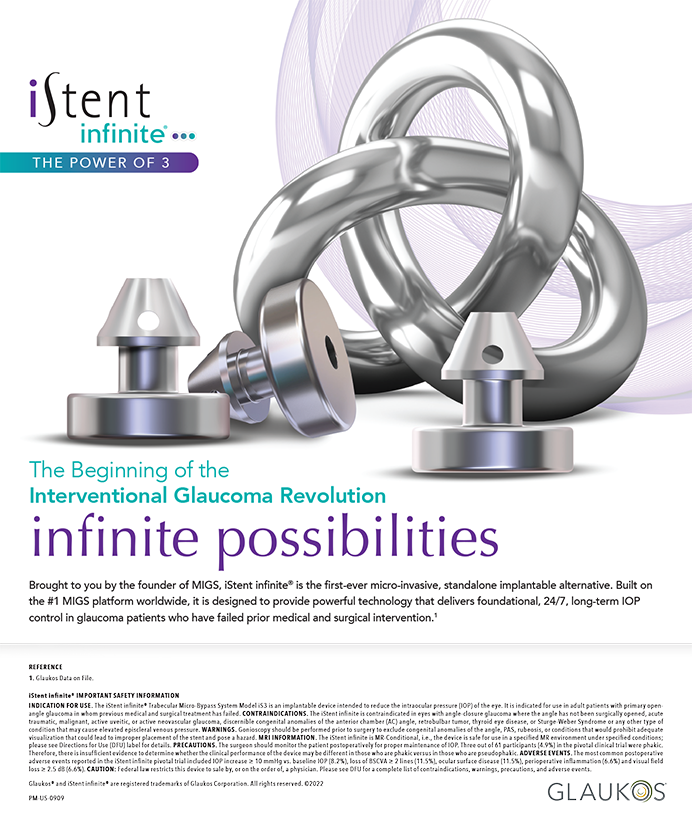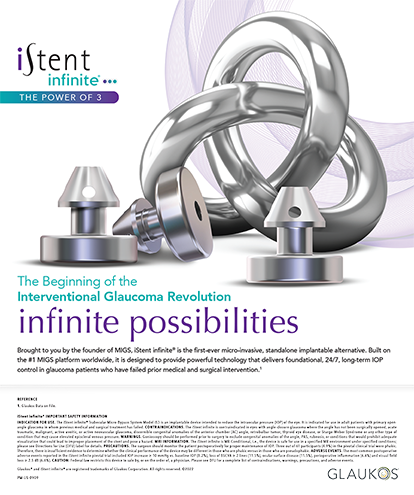CASE PRESENTATION
A 49-year-old man requests a consultation to discuss refractive surgery options. The patient describes himself as exacting. He is an on-air personality/host for a local television station, an avid outdoorsman, and a competitive (nationally ranked) archer.
The patient only uses glasses to read small print. He states that, if ambient lighting is “good,” he can function well without any correction. He did not use any correction for distance until recently, when he borrowed a friend’s +1.50 D readers and found that he could see his targets (both moving and stationary) with much greater precision.
Overall, the patient’s health is normal. He has no past medical history of significance and takes no medication. His past ocular history is significant in that, 10 years ago, he was “poked in the right eye with a branch.” He did not require surgical intervention at the time.
An ocular examination shows a UCVA of 20/20- OD and 20/25- OS. The patient’s manifest refraction measures +1.50 D = 20/15 OD and +1.75 D = 20/15 OS. His cycloplegic refraction is +1.75 D = 20/15- OD and +2.00 = 20/15- OS. The IOP measures 17 mm Hg OD and 16 mm Hg OS, and pachymetry readings are 545 μm OD and 542 μm OS. The pupils are equal and reactive to light without an afferent pupillary defect. The extraocular muscles and visual fields are normal.
The slit-lamp examination shows the anterior segment to be normal except for a well-healed, full-thickness puncture wound as seen after penetration by a fine thorn (Figure 1). The fundus is normal. The results of diagnostic testing are shown in Figures 2 to 6.
How would you counsel this patient? What surgical intervention, if any, would you offer? Does flap creation with either a mechanical or laser keratome raise any concerns given the apparently full-thickness injury/scar?
—Case prepared by Parag A. Majmudar, MD.
WILLIAM I. BOND, MD
Counseling and setting realistic expectations are key here. The patient was entirely happy with his vision before an accidental discovery. The main thing is not to give him any reason to be less happy after any procedure than he was before it.
In my opinion, the full-thickness scar makes LASIK inadvisable, certainly with a laser keratome but also, I believe, with a mechanical keratome. The chance of disaster is just too great, especially in a virtually asymptomatic patient such as this one. It is well known that hyperopic PRK is less reliable than hyperopic LASIK, but the former and no surgery at all seem to me to be the only genuine options here.
The case presentation did not touch on any ocular dryness. I would thoroughly evaluate the tear film. I would also carefully explain to the patient that vigorous treatment of any ocular dryness must occur before or after surgery and that temporary punctal occlusion might be indicated.
I would counsel the patient that his vision will be problematic for a few weeks after hyperopic PRK but that his reading vision will improve first. I would target an outcome of +0.25 or +0.50 D at most. A plano result would, of course, be fine, but I would err on the side of hyperopia. Any degree of myopia, however small, in this patient, whose television livelihood and hobbies depend heavily on distance vision, will be poorly received.
I would stress to the patient that his recovery from PRK will probably be slower than either of us would like. If he declined to proceed, so much the better. An excellent case can be made for no intervention. The patient would probably be very happy after PRK, but there are numerous facets of this case in which there is nowhere to go but down.
MARK KONTOS, MD
I have learned that it is important with patients like this one to match their expectations with the realities of the surgery that is eventually selected and to make sure they participate in the decision-making process. These goals require lots of educating, listening closely to what the patient says, and asking many questions. One of the first things I would ask this patient is if he expects not to need reading glasses after surgery, both now and in the foreseeable future. I would impress on him that his eyes are changing at this point in his life, that they may continue to change in the future, and that these alterations will affect how successful and lasting some surgeries will be.
If he is comfortable with reading glasses and not concerned about having additional surgery in the future to remain emmetropic, then the options are primarily laser based. I would also discuss hyperopic Visian ICL surgery (STAAR Surgical), even though the lens is not readily available in this country. (I live in the Pacific Northwest, and Vancouver is very accessible to my patients.)
If laser vision correction were pursued, I would perform wavefront-guided LASIK and adjust the treatment toward the manifest refraction. I would be concerned about the scar in the patient’s right eye, because I have encountered problems when forming the flap with a femtosecond laser in cases like this one. I would therefore use a mechanical keratome on his right eye and the laser on his left eye.
If the patient were interested in a more permanent solution and wanted his best chance at long-term independence from glasses with one surgery, I would discuss refractive lens exchange. In this scenario, I would recommend a laser-assisted lensectomy followed by implantation of the Crystalens (Bausch + Lomb). Because he is a television personality, I would counsel the patient on the lens reflections that are sometimes seen on camera and explain that his lighting and camera technicians can adjust for them.
KEITH A. WALTER, MD
My first thought is to exercise caution in offering any treatment plan to this patient. Latent hyperopes are difficult to deal with, because they have yet to fully grasp how quickly their visual acuity will deteriorate over the next several years. Oftentimes, they will brag that they had “eagle vision” in their youth, and considering this patient’s hobbies, he is likely expecting a return to those glory days.
First, I would explain what will happen in the next few years, as his latent hyperopia becomes more manifest. I would gently suggest he wait before pursuing a definitive surgical solution until his true measurements are more evident. Maybe daily wear contact lenses for his more avid outdoor days are the best solution for now. After a few years pass and a more solid doctor-patient relationship develops, I would get his thoughts on possible surgical solutions if and when he becomes contact lens intolerant. At such a time, it is to be hoped that he has full-blown presbyopia and requires reading glasses on top of his contact lenses.
I would avoid LASIK because of the patient’s scar and lack of presbyopic correction. Instead, I think he will be an excellent candidate for a refractive lens exchange with use of a femtosecond laser and a premium presbyopia-correcting IOL.
Section Editor Stephen Coleman, MD, is the director of Coleman Vision in Albuquerque, New Mexico.
Section Editor Parag A. Majmudar, MD, is an associate professor, Cornea Service, Rush University Medical Center, Chicago Cornea Consultants, Ltd. Dr. Majmudar may be reached at (847) 882-5900; pamajmudar@chicagocornea.com.
Section Editor Karl G. Stonecipher, MD, is the director of refractive surgery at TLC in Greensboro, North Carolina.
William I. Bond, MD, is a cataract and refractive surgeon at Bond Eye Associates and an assistant clinical professor at the University of Illinois Medical School, both in Peoria, Illinois. Dr. Bond may be reached at pekineye@yahoo.com.
Mark Kontos, MD, is the senior partner at Empire Eye Physicians in Spokane, Washington. He is a consultant to Abbott Medical Optics. Dr. Kontos may be reached at (509) 928-8040; mark.kontos@empireeye.com.
Keith A. Walter, MD, is an associate professor of ophthalmology at Wake Forest Baptist Medical Center in Winston-Salem, North Carolina. Dr. Walter may be reached at (336) 716-4091; kwalter@wakehealth.edu.


